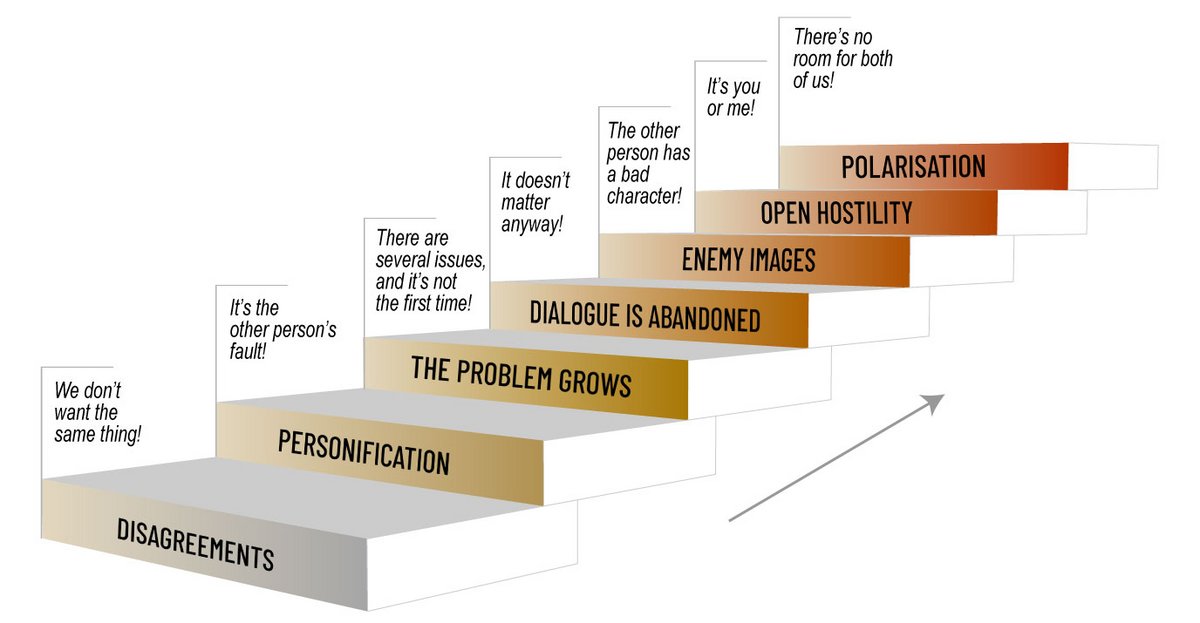Conflict management
We all have a responsibility to create a workplace culture in which conflicts are handled competently. Managers have a particular responsibility to learn how to deal with conflicts – both to manage conflicts among their staff and to help staff manage conflicts themselves.
Conflict escalation ladder
This model can help you understand the different stages of a conflict and the best way to act in a specific situation. Based on where the conflict is on the ladder, you can determine which strategy will best manage and deescalate the tension. It is important to intervene before the conflict escalates.
The seven stages of escalation
- Disagreements: Disagreements or differences of opinion arise. At this stage, the conflict can often be resolved through open dialogue and understanding.
- Personification: The conflict begins to take on a personal dimension. At this stage, the parties may develop negative feelings towards each other, which may lead to misunderstandings and mistrust.
- The problem grows: The conflict escalates further. Misunderstandings intensify, and the parties find it difficult to see the situation from the other party’s perspective. The conflict begins to affect other areas or people.
- Dialogue is abandoned: Dialogue is replaced by monologue or complete silence. There is an unwillingness to listen or to understand the other party’s point of view.
- Enemy images: The parties begin to view each other as the enemy. They regard each other as the cause of the problem and attribute malicious intentions to each other.
- Open hostility: The conflict is now openly hostile. The parties may resort to verbal aggression, backbiting or undermining each other’s work. Cooperation becomes virtually impossible.
- Polarisation: The conflict becomes polarised and both parties are locked in their positions. Coalitions may form and the conflict may spread – in which case the entire work environment may be affected.
How can we create a conflict competent culture?
Creating a conflict competent culture in the workplace requires us to work together to develop an environment in which conflict is seen as a natural part of collaboration – and in which we have the necessary skills and tools to prevent conflicts becoming harmful to the individual and the work environment. We must be able to manage conflicts if they arise.
Here are some of the main ways you can create a conflict competent culture:
Preventing conflicts
- Promote honest and open dialogues in your everyday work practices. This includes creating a psychologically safe space in which employees feel they can express their opinions, concerns and feelings without fear of reprimand. Read about Psychological safety at AU.
- Educate and train employees in how to use their communicative skills to promote good collaboration and improve their interpersonal competencies. And how these skills can help navigate – or avoid – conflicts. One way to do this is to explore how parties in a conflict can help to deescalate the conflict.
- Come up with a conflict code of conduct. This can help create a consensus on how conflicts are understood and managed in your unit. It also signals that constructive conflict management is a skill that you prioritise.
Managing conflicts
- Improve managers’ conflict competencies so that they are better at identifying, intervening in and deescalating conflicts effectively. This includes knowing what you can do as a manager (e.g. offering conflict resolution mentoring / mediation) and when you need to call in external assistance.
- Highlight the (potentially) positive aspects of the conflict. Learn to view conflicts as opportunities for growth and innovation. By embracing conflict and making room for professional disagreements, you can foster an environment in which diverse perspectives and ideas are valued.
Following up on conflicts
- Feedback and reflection. Make it a priority to give regular feedback so that employees and managers can reflect on how conflicts are managed and learn from experience. This promotes a culture in which continual improvement is valued.
- Revisit and evaluate the conflict code of conduct regularly to jointly assess whether you are using it and/or whether it needs to be revised.
The manager’s role
As a manager, you play a vital role in managing conflicts before they escalate and creating a conflict competent culture in the workplace.
Here are some things you should consider when handling a specific conflict:
- Conflicts are about an issue and affect a relationship: To ensure that a conflict is managed sustainably, it’s important to work on both the issue and the relationship in question.
- Offer conflict resolution mentoring or mediation: To manage a conflict, you can either offer conflict resolution mentoring to the individual party/employee with a view to helping them take the issue further and manage the conflict themselves. Or you can offer conflict mediation to both/all the parties who are involved in the conflict and who are unable to resolve the issue themselves.
- Consider your role in the conflict before you decide how to manage it: It’s important to be able to relate to the issue and the conflict impartially – so it’s essential that you ask yourself whether you have a role in the conflict.
- Use the conflict escalation ladder model: To assess the challenge you’re facing, use the conflict escalation model to determine the level and type of conflict.
- Ask for advice: Are you able to manage the conflict yourself? Consider whether you have the necessary skills to manage the conflict or whether you need to ask for advice on how to deal with the situation.
- Consider whether you need to call in external assistance: In addition to offering advice on how to manage the conflict, your HR partner can help you find external assistance – either from HR or from an external consultant.
- Consider whether you need to take employment legal measures: Discuss any issues relating to employment law with your HR partner.

